#i fully understand the issues but they are a disabled body's godsend
Explore tagged Tumblr posts
Text
i just spent $200 on amazon's big deal day sale and honestly? i'm probably going back for more, they get me EVERY TIME literally if i had a following i would do a haul of just...soaps
#don't @ me about amazon fr i can't carry my washing liquid i need the man to do it for me#i fully understand the issues but they are a disabled body's godsend#i bought so much soap
15 notes
·
View notes
Text
SAVING LIVES TWO AT A TIME

Breed Rescue Dog of the Year Dog: Sir Jack Spratticus the Border Terrier Owner: Vanessa Holbrow, 46, from Berrow, Somerset (Neil Munns Photography)
Taking me, a Border terrier (BT) called Jack, on as a re-homed BT in 2012 helps mum live with complex mental health illnesses. Namely these issues are Borderline Personality Disorder (BPD), Complex Post Traumatic Stress Disorder (cPTSD), Dissociative Disorders (DD) and an Eating Disorder (ED) (which is 90% a restrictive type, Anorexia). I give mum a life she never dreamt off in terms of companionship and I help her to get out and about (this was prior to us finding an Owner Trained Assistance Dog (OT AD) organisation). This I will elaborated on later. Mum maintains it is literally a Godsend to have discovered Border Terrier Welfare UK (BTW), and it is by no means an understatement to say this has been a life changing ‘find’. Mum and I from the beginning have been learning and growing together, overcoming difficulties from our pasts and learning coping strategies. Mum was introduced to an extraordinary Twitter group in 2013. #BTPosse is a Twitter group of over 1000 Border Terriers and their owners who support each other, share photos, thoughts, news and laughter on Twitter and Facebook and arrange Tweet Ups all over the country, where they meet for a day of fun, dog walking and picnicking; and then an OT AD organisation in 2017. The OT AD organisation is “a not for profit organisation, helping disabled people within the UK wanting to train their own assistance dog to an extremely high standard”. Which is where our next chapter continues. For now I shall start from the beginning of my life with Mum aged 13 months.
On 24 August 2012 I walked into mums life with an air of bravado. I say an ‘air of bravado’ because this was a fragile exterior, masking deep fear and confusion. This was my fourth home. Between you and I, to be rejected again was my reality. On appearances those on the outside may have indeed questioned why I was being re-homed to an individual with complex psychiatric illnesses. Furthermore mum lived in a small block of flats with no enclosed garden. Pfft! to that I thought to myself at the time. I need squirrels to chase at least! Mum’s complex psychiatric history is an extensive one, thirty six years living and fighting to manage daily living. Mum has struggled to the extent that two thirds of her life since graduating in 1993 with a BSc in Applied and Human Biology has been sectioned in old style asylums to begin with and then general adult psychiatric hospitals, specialised eating disorder units and general hospitals. The latter of which mum has been hanging on to life by a hairs breath several times on life support 1994 and 2002 due to attempts on her own life. Along side this, on more times she can dare mention, mum as an adult has fought back from being insanely underweight, due to self imposed starvation. Beyond the usual conditions brought on by malnutrition and an unviable body weight, a plethora of other conditions result and remain, for example, Osteoporosis.
Gradually over the last twelve years, with the help of intensive and less intensive therapy mum has turned things around to a certain degree. Problems partly stem from an unrelenting traumatic and lonely, neglectful existence during her formative years and as a young adult. Therapy enables mum to gain insight, and as a result of this a chance to gain a sense of self, which is in itself excruciating for mum to face. Trauma therapy continues to this day.
Before I came along Mum started on her journey to becoming a dog owner. Mum started volunteering as a dog walker for the RSPCA, moved to rented accommodation permitting dogs (in light of recommendation from community mental health services) and attended dog training classes without a dog. Mum explained to me that in order for her to feel in any way able and have the chance to hold confidence enough to become a responsible dog owner, this was a definite prerequisite.
I offer mum someone to love and care for. One thing that is novel for mum is my love and acceptance of her. I help her to strongly consider looking after herself, to believe in looking out for herself first and foremost. I help her initiate the want to discover a sense of self and the strength to process that complexity. She adores me I know, furthermore I am integral to her working hard to stay on track (safe) because I sense I am very special to her. Being a extraordinary character would be one descriptive word for myself. I am also adorable and mischievous despite unsavoury terrier habits! An extraordinarily adaptable poser is a further attribute and love nothing more than being in front of the camera. A designer, Izabela Peters, spotted one of my photos and this resulted with me being on a cushion and a draught excluder of all things! I model for ‘Scrufts’ handmade dog collars and leads, with mum taking the photographs for this. Before I came into mum’s life she never realised she was able to take a decent photograph. Towards the end of 2017 we had the surprise of a lifetime to win a competition. ‘Dog Friendly’ (the largest database of dog friendly places to stay in the UK) ran a competition to find twelve dogs with the friendliest faces to feature in this years Dog Friendly Face of the Year Calendar. The competition attracted more than 3,000 entries and 35,000 votes. Celebrity judge Paul Martin chose me as one of the 12! The winning photo is heading this piece of writing. Below is one of my good self taken me at the Excell Centre, London where the awards were held.
On the side, may I also mention, in 2014 I qualified for the Buckham Fair, Re-homed/Rescued Dog Championships. I qualified for this show at Mid Somerset Show where I received a first (mum was in tears). So the following week mum dragged me down to Beaminster, in torrential rain might I add, to be judged along with approximately 70 dogs. Mum was questioned by four judges on different aspects of our story. Then there was a big finale and it was not until this stage mum and I realised how many amazing dogs we were up against. Martin Clunes talked to mum and stroked me. Following this ten dogs were pulled out to stay in the ring. Number 26 was announced (my number!). After a further circuit of the ring and one final look at us. In reverse order the positions were announced. To my complete shock and delight I came 2nd! It may be worth sharing with readers that in 2016 having been nominated, I was short listed for The Kennel Clubs Eukanuba ‘Friends For Life’ (FFL) competition. At the age of 4 I was nominated for the huge impact I had had on mum’s life. That nomination went no further.
However, in 2018 I was selected from the Breed Rescue category for The Kennel Club FFL competition, which celebrates the close bond between dogs and their owners; and showcases how dogs can be true heroes and make an extraordinary contribution to our lives and in many cases, change our lives. I was one of five dogs to make it to the final and the public then voted for the winner. The remarkable finality was actually winning, and so mum and I received £5000 for our chosen charity. This had to be Border Terrier Welfare UK. Mum and I were presented with our award by Geri Horner (nee Halliwell), who described us as a ‘beautiful partnership’. Meeting Professor Noel Fitzpatrick was unbelievable. What a remarkable individual and I know this is a vet mum watches on the television daily, and is an important part of her routine (which she indeed told Professor Noel!).

20180311 Copyright Flick.digital Free for editorial use image, please credit: Flick.digital Picture shows the Friends for Life finalists Gayle Wilde, Sarah Mohammadi, Vanessa Holbrow (winner), Hannah Gates and Clare Syvertsen, joined by Geri Horner (middle), (Sunday 11.03.18), the fourth and final day of Crufts 2018, at the NEC Birmingham.
Mum credits me with helping her, but in reality we have helped one another. Mum took the role of dog ownership seriously. She researched the breed thoroughly prior to rehoming me and took me to various training classes. In the early days we consistently incorporated into our daily walks moves we had learnt in training classes, for example, heel work to music, and agility classes. Our first class (in obedience), the initial paramount lesson to master was how to refrain from barking and lunging for others dogs, for example. I could not understand the logic of mum and I being confined to no more than the space of a cupboard every time I exhibited unacceptable behaviour. We were excluded from the first few months of obedience sessions. Every time I opened my mouth, mum quietly took us into the cupboard (a small room in reality). In time I learnt why. If I didn’t bark then I was allowed to take part in the class; if I challenged myself to leave a dog alone that was starring at me, I could stay in class… bingo! To keep my focus solely on mum was the foundation to learning more acceptable behaviour. That was all that was required; I had cracked it! Little did I know there were many many more lessons to come.
May I remind at this stage of writing we are 4 – 5 years prior to finding an owner trained assistance dog (OT AD) organisation and thus training to become an assistance dog began. Years before this there were significant challenges to overcome. This had to be partly due to a miserable start in life before I was handed into the care of BTW. To behave acceptably and with manners around other dogs was certainly something I did not excel at. Socially I had been deprived. ‘Turning on’ mum without letting go until a good bite had been executed wasn’t an unusual occurrence (I had no bite inhibition). It was a frightening time for both of us, I know it was for mum as I was unpredictable when out walking. I was her first dog so our learning curves to overcome immense challenges and to bond I have to say, we fully embraced. Mum had to filter individuals opinions regarding my behaviour. For example, a common theme was I required a muzzle whenever out. Mum was determined that with consistency, love and firm boundaries we would eventually turn a corner. And that we did. Step by step, many of which were backward steps we turned more corners. This came with an inventory of failures, tears and unimaginable anxieties on mum’s part. It took approximately a year before off lead walking along a dog friendly beach was possible. To say the least, our trust and connection has grown considerably. I offer mum a new chance and opportunity in life, one of worth and purpose, and mum offers me a safe and loving home. We’re both as mad as each other (actually mum is the maddest!) and not afraid to challenge others when it comes to the understanding people have of mental health illnesses, with a passion to breakdown the stigma attached to mental health. Mum has spoken on local BBC radio on several occasions, has given talks to nursing students, written articles for Rethink and other mental health charities. Raising money for mental health charities will continue to help spread awareness and raise understanding, as well as supporting the charities themselves. This has occurred due to my coming into her life. For example, 2015 we raised £2000 when I gave mum the challenge to shave her head; 2017 we baked 725 dog treats. That number represents the number of people in the UK diagnosed with an eating disorder. And we have just walked 7 miles raising £1400. al this is for Beat (UK Eating Disorder Association). Together we have several aims, one of which is to continue supporting charities including BTW (this started with items sold in aid of BTW “Spratticus Creations” cards 2012 – 2014 which mum made using original photos of myself. Then mum learnt to make Jewellery 2014 which is now sold in a local shop.
necklaces
variety if rings using Miyuki or bicone beads
decorated hearts
The Jewellery is proving a success and a therapeutic activity for mum, so now I have jewellery and other homemade products named in honour of me “JackSpratt Jewellery” or “JackSpratt Design”).
Memory wire bracelets – glass beads
Kumihimo
Mum and I mostly in spring and summer, arrange tweet-ups here where we live. Which is very close to a 7 mile dog friendly beach. Where all my pals near and far are invited to join to spend a day out together. Causing mayhem on the beach! At the same time mum meets her now best friends can meet up and could get to know new members. They always include a stop in dog friendly pubs or cafes of course. I reiterate this is prior to finding an OT AD organisation.
Mum’s ultimate aim, with the support of her Community Psychiatric Nurse since 2013 to date, was researching whether there was any chance I could become her legit Assistance Dog (AD). In effect that is exactly what my intention had been up until this time, but we needed this to be under a genuine organisation and of course legal. I was also keen to add AD tasks to my repertoire of ‘tricks’ mum had trained me to perform. To have the privilege to remain together, for example in public buildings, and for mum to have the reassurances/help from an approved assistance dog would have a positive impact on the quality of her daily life. Mum and I would spend hours working together, having fun e.g. learning to skate board. Our walks were never without fun, playing impromptu games, and dance moves, and utilising anything to aid our training e.g. weaving through bollards. Why were we so keen? Why not! An opening for and the potential to help mitigate some of the symptoms that disable Mum would open up her life in ways one is unable to put into words. This we predicted would be the pinnacle to our journey, but never imagined possible as psychiatric service dogs were only recognised in USA (or so mum thought).
Further residential treatment has been recognised as necessary to enable mum to address complex & lengthy historical trauma. Within the NHS this is out of the question. So, between me, a private trauma counsellor, her local community psychiatric service, friends and mum herself, we do our best to minimise the risk to her health. She has no family, apart from an aunt who could not live further away – in Tasmania!
2017 is a year that stands out significantly for our journey. August 2017 marks the beginning of a dream becoming reality (and proof that an old dog can be taught new tricks!). At 6 years of age I am perfecting tasks which will be elaborated on later. Currently I am midst my training in obedience (even though I passed my level 1, 2, & 3 in obedience in September 2017, photo below, it is imperative obedience training continues as part of daily routine) together with being able to perform tasks. Furthermore, it is essential I train to work while amongst distracting public environments. So am currently clocking up the necessary number of hours in Public Access before there is any chance of mum & I being ready for the Public Access Test. All this is ultimately so I may help mitigate disabilities specific to mum, and this I must do in order to become an official (and legal) AD. My behaviour or even presence alone is not to provide emotional support (though obviously this is a quality I hold). What I mean to say is this is not sufficient alone to class me as an AD. My behaviour, currently being shaped, is to perform tasks which enable mum to function in an ordinary way a non-disabled individual may take for granted. So mum formulated and adjusted tasks specific to her needs that she is now training me to accomplish. The tasks I carry out for mum, may not be a task for another person. Humans are individuals, hence how they experience any said disability is unique to them.
Medication retrieval; deep pressure therapy (DPT); alerting mum should she disassociate by nose nudging or tactile stimulation; emptying the washing machine; picking up dropped items; carrying items down the stairs; going back up the stairs to retrieve a forgotten item; retrieval of the landline, television remote, mobile phone – all on cue. These are a selection of the tasks I have learnt and some require further work and proofing in order to reach the high standard required. Having said that I already benefit and empower mum on many levels, by performing tasks, so that she may live with complex mental health illnesses independently in the community.
Perhaps now would be a good idea to elaborate a little into what it means to live with mental health illnesses. Since this is in essence what I help alleviate the extremes of. Beginning with Dissociative Disorders (DD), these are a range of conditions that include Depersonalisation and Derealisation. I will try to keep this simple as this certainly is in no way straight froward. No wonder mum doesn’t know whether she is coming or going!
Dissociation is an entirely normal response to overwhelming trauma and something mum suffers with to this day (it is a little more complex to that we all experience, for example not remembering a part of or all of a car journey. A mild example of an episode of dissociation). It is a way mum has survived enduring ongoing abuse that otherwise would have been unbearably painful. It is not uncommon for those like mum with cPTSD to also suffer with other disorders such as DD. The brain can utilise dissociation as a coping method. Mum, I suspect narrowed down her consciousness, and failed to ‘join up’ the different strands of her experiences. This is said to be particularly experienced by child abuse survivors, who are emotionally unable to cope with trauma in the same way an adult can. So mum may have an emotional memory (eg terror, disgust, shame) of what happened in what she was exposed to but no ‘visual’ record. On the other hand mum can have a vivid mental picture of what happened, but this is disconnected from her feelings, so it is as if it didn’t affect her: she feels numb or nothing. Empty. A stranger to herself. The traumatic experiences are ‘unintegrated’ and take on a life or identity of its own, separate from her main stream of consciousness. For mum she experiences difficulty as well as emotional pain making a connection between what happened and how she feels, or its impact on her in terms of how she feels or behaves now. Mum struggles to connect with the fact some things happened at all. These same difficulties can be related to things that happen day to day and not necessarily with respect to past traumas. Mum may suffer with another form of DD, Dissociative Identity Disorder. This is due to her experiencing changes in her identity. Following on from this, different facets of her identity are in control of her behaviour and thoughts at different times.
Mum is diagnosed with cPTSD. The impact of complex trauma as a child where there is no way to escape is very different to a one time or short-lived trauma. The effect of repeated/ongoing trauma – caused by people – changes the brain, and also changes the survivor at a core level. It changes the way survivors view the world, other people and themselves in profound ways. Symptoms are numerous, for mum perhaps the more prevalent ones are re-experiencing the trauma(s) through flashbacks (emotional and visual) or nightmares, helplessness, ‘terminal’ aloneness, deep yearning for someone to come and rescue her (yes subconsciously this may continue on years after trauma has ceased), increased arousal i.e. difficulty falling or staying asleep,��feelings of detachment, derealisation and hyper-vigilance. There are a number of ways I am being trained to perform tasks that can help mum with the complex web of conditions I have attempted to present you. Trauma for any person, but in this case for mum, unfortunately has devastating consequences on her. Furthermore, will contribute to eating disorders, depression, panic, Personality Disorders and as I have a ready mentioned DD.
Before this I think it is best to give you the lowdown on Borderline Personality Disorder (BPD), then that covers the majority of mum’s mental health conditions and puts into perspective why, and how, I may help mum. I feel this background is important as it does what we are also passionate about which is to help spread awareness and breakdown stigma attached to mental health illnesses. Individuals with BPD may often suffer from other psychiatric disorders (comorbidity) and I hope evidence for this has been made apparent. Unfortunately mum lives with problems that are thought to commonly co-occur with BPD notably depression, substance abuse, eating disorders, anxiety, panic disorder. Combine that with a wide range of symptoms BPD can cause, one may see what a complex existence mum has! When you hear about BPD, symptoms such as a fear of abandonment; mood instability; unmanageable anger; an uncertain sense of self; a pervading sense of emptiness; suicidal behaviour; urges to self-harm; stress-induced paranoia; episodes of dissociation. Despite its often-misunderstood title, BPD is essentially a label describing a range of persistent problems that affect various aspects of a person’s life.
So how on earth do I help mum cope with what appears to me such a chaotic, mind numbingly nonsensical concoction of disabilities?!! From the previous few paragraphs one may speculate how I help mum.
To elaborate on the specific tasks I perform. I locate and retrieve mum’s medication to her on the cue “find green”. She takes a range of prescribed medication four times a day, and as required to alleviate symptoms related to psychiatric conditions and pain relief. I am able to retrieve these where ever she is in her flat. Note there is no risk to me as they are contained in a dosset box, which is then in a thick zipped canvas bag. Some may wonder why “find green”? Well, cue words for me materialise as mum shapes my behaviour, and we go with what emerges to work for us as a team. The ‘once upon a time’ meaningless word is now a meaningful, effective command yielding a reliable behaviour.
Deep Pressure Therapy (DPT) is remarkably effective. The cue word mum and I have found works is “lap”. I have never been a lap dogs so I really had to learn to adapt to this alien position, and remain there. On hearing this word, even if I am comfortably settled myself, I will lie across Mum’s lap which has various consequences for mum. For example, the weight of my self on mum’s lap reduces anxiety, and panic. DPT also has the potential to disrupt a dissociative state, interrupts racing and intrusive thoughts. Basically mum’s brain has difficulty processing a lot of information – arising internally from thought processes, for example, together with external stimuli which may be something as subtle as a trigger such as bright lights or someones voice. DPT is said to be a firm tactile sensory input that provides proprioceptive input (i.e. sensations from body tissues that underlie body awareness to the whole body). So, when I lie across mum’s lap (I also lie across her chest in response to the cue of her distress) this in effect administers a calming, organising effect. It is widely known that DPT decreases this “fight or flight” sympathetic activity and decreases the level of cortisol (a stress hormone) which is hugely impactful for people like mum who experience stress, anxiety, or fear on a regular basis. DPT has a wide and varied effect for mum by helping her also to ground herself in the here and now e.g. when DD states tempt mum to detach from reality and expose herself to further emotional agony and intense cognitive dissonance.
DPT also has another major affect on mum in her battle and determination to minimise and/or stop self injury. Many people may have heard of this, we have called it self injury as opposed to self harm to distinguish between the many facets of self harm many of us, whether we know it or not, engage in (e.g. smoking, excessive drinking). Therefore I am able to perform tasks such as picking up, holding and retrieving items, whether mum has dropped them on not, on cue. To date I have managed to pick up all manner of items, including mum’s mobile phone, purse, keys, and even bags my size and drag them down the stairs for mum. I even untie her shoe laces and empty the washing machine for her.
The following is not recognised as an AD task but felt it important to include in this piece on how I help mum. Some things that aren’t talked about as much are the difficulties with object permanence (or object constancy) and time perception. Object permanence is understanding that objects continue to exist even when they can’t be observed. Time perception is the subjective experience of time. These things are important when it comes to maintaining friendships and relationships. It can cause a lot of problems if you forget that someone exists as soon as they leave. Where mum is concerned, logically she knows there are friends who care about her, but when she is not around them, it’s very difficult for her to remember that. She has trouble creating an image of them in her mind. Even if it’s only been a few days since she spoke or saw them, it feels like it’s been weeks, if not months. So she has significant problems holding onto a consistent mind image when it comes to relating to another. Even after a few hours without a friend/professional, she starts to feel like it’s been much longer and she can feel herself forgetting her last interactions, and what they look like. Each time she reconnects with anyone, and that includes me (after her stays in hospital for example), she fears forgetting people exist. She takes a picture of her therapist for example to help her remember time spent with her was real. She may avoid seeing friends because she does not feel like she knows them and it creates incredible amounts of anxiety for her to reconnect. I am a constant in her life, and that helps instigate her to maintain contact with her friends. In turn her friends own dogs who are my pals, and that contact is paramount for my welfare.

Mum says that in teaching me, she continues to gain a sense of self, and consolidate what Community Mental Health Services guide her in, for example looking after herself and building healthy boundaries. Mum and I are a great partnership because we continue to build on our skills socially, and now people know her as ‘Jack’s mum’ and not necessarily because of mental health problems. I am a proud member of a twitter group called hashtag Border Terrier Posse (#BTposse) and as a consequence have made many Border Terriers pals who I meet up with regularly at ‘tweetups’ (a meeting of Border terriers!). Furthermore, Mum has made the best of friends life can bring. Mum and I arrange ‘tweet-ups’ (on a dog friendly beach here I live) where approximately twenty of my pals come along to zoom around the beach creating controlled chaos, and make certain we leave a trail of terrier mayhem! So although mum struggles holding a sense of continuity and consistency about people in her life, I have a purpose in aiding mum in her desperate need to hold on to the physical connection or to seek reassurance of others’ love or that they are there, because people with BPD may struggle to hold onto the concept of self without the help of others. Survivors of trauma often feel so little connection and trust with people, they remain in a terrible state of aloneness, even when surrounded by people. Mum describes it as a glass wall between herself and other people. She can see them, but cannot connect with them. People like mum may need others to constantly remind them of the fact that you love and care for them. I can do this for mum. Although I must reiterate this is not a task that would legally qualify me to become an AD.
There are tasks that help disrupt sudden emotional overload. For example, in response to the cue word “legs”, I return to mum (if off lead) approaching from behind and sit between her legs leaning in to the inner right hand side leg (when we are away from home this we have found becomes acutely useful). For mum tactile stimulation is invaluable as this also helps dilute fear or hyper vigilance. I will lick mum’s face in response to the cue word “kiss kiss” or if she appears drowsy/motionless. We have found this may be performed in conjunction with the “nose nudge”. This is a further task performed on hearing the cue word “nose” or in response to mum’s watch timer (which she sets to go off regularly when out walking alone). I will nudge her knee with my nose until I get a response (i.e. a reward). The nose nudge for mum as well as aiming to disrupt emotional overload, overwhelming fear, disassociation and hyper vigilance also prompts mum to engage mind/body regulatory exercises e.g. deep breathing/mindfulness.
These are a few of the tasks whereby mum has been shaping my behaviour in order that I may be able to reach the status of Assistance Dog. I have had to be trained so that I behave to a professional standard within a public building. For example, in cafes and restaurants I now settle in a down, quietly under a table or close to mum, and not cause any disruption. Compare this to a time only a year ago in a favourite dog friendly cafe, where I would have been allowed to hoover up crumbs at the end of a days service. I’ve had to change habits mum has allowed me to perform so at times it’s been a challenging and perhaps confusing experience!
In essence, when a child’s needs are not met and they experience repeated traumas, this has the potential to profoundly affect their development. Mum, I expect, often continues, albeit subconsciously, wanting those unmet childhood needs in adulthood: safety, protection, being cherished, guidance and loved. This can be where I have a vital influence and active part in helping mum. However, the natural behaviour I have, for example companionship, licking and comforting mum are not considered tasks even if they helped her. So in order to help mum I am being trained to perform specific tasks that mitigate the symptoms and disabilities related to complex mental health illnesses mum experiences. I hope this piece has provided an adequate overview of how training me to become an assistance dog helps mum’s intense cognitive dissonance and vulnerability. In addition, I want to provide insight to what it is, to live in the shoes of mum, and many like mum. I have also, without intention, conveyed how a rehomed dog has, against all odds, become an AD in training with a hope to ‘graduate’ in the not too distant future. The difficulties outlined make mum’s daily life a challenge. She is so grateful to have me & friends who love, and accept her, and she is doing her best to do the same for herself. The training mum and I do has been a welcomed learning experience. The training, by positive reinforcement alone, is wholly rewarding; relationship building; exciting; fun; and provides the motivation she needs to continue spreading awareness and challenge the stigma and misunderstanding attached to mental illness. Every day is an opportunity to learn and give what we can to those around us, one thing I am reminded of every day is the inspiration I give, and difference I make.
To conclude, the final message to convey is how indebted we both are to charities such as Border Terrier Welfare, UK. The #BTposse and other profound opportunities. Without these life changing openings Mum, I strongly expect, would not be here to help me tell you this story.
Auto-bark-ography! An update 2018 SAVING LIVES TWO AT A TIME Taking me, a Border terrier (BT) called Jack, on as a re-homed BT in 2012 helps mum live with complex mental health illnesses.
0 notes
Text
POODLICIOUS
In my mind, this odd little slice of my life runs on a loop:
I am dancing around the kitchen with a black and white miniature poodle. He dances on his hind legs, all people-like, and I sing various made-up songs. Like ‘Poodlicious’—to the tune of ‘Fergalicious,’ of course, with lyrics about how Kimba makes all the girl-dogs go loco.
That poodle goes wild. He chirps, and—I swear—he smiles.
The musical repertoire varied, but for a number of years, this scene was the norm as I put on the coffee and made breakfast each morning. I had somehow become a crazy little-dog lady, and my dances with Kimba put a smile on my own face even in the worst of times.
Our pairing was as unlikely as the bond we ultimately formed.
I grew up with large dogs: German Shepherds, Rottweilers, Newfoundlands. I had nothing against small dogs. I just tended to prefer the big, slobbery, heavily-shedding dogs I’d known all my life.
But because of my (now ex) husband’s allergies, those big, slobbery, heavily-shedding dogs weren’t an option. After some research, we ended up with first a Bichon Frise—Harry, who quickly chose my ex as his favorite human on earth—and Kimba, the miniature parti poodle who became my shadow.
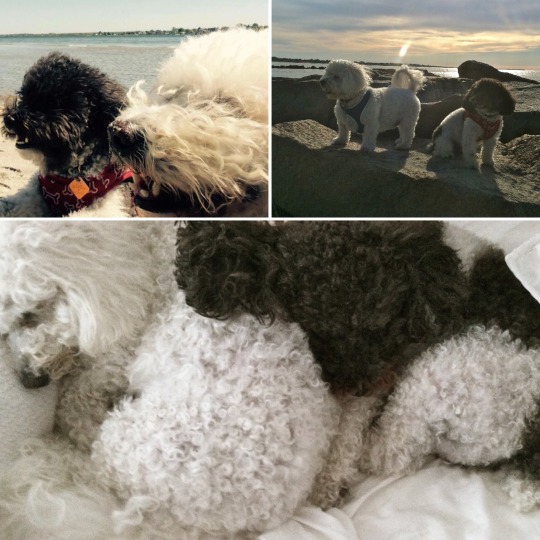
Kimba arrived with a serious case of separation anxiety. Or maybe more accurately, everything anxiety. He was constantly between my feet. Noises and sudden movement sent him into a tailspin. He was so terrified in the car, he shook uncontrollably, frothing at the mouth until he looked like a tiny parti-poodle version of Cujo.
In a way, Kimba’s anxieties were a godsend for me. I was dealing with anxiety of my own, and working with Kimba on his issues proved to be therapy for both of us. We spent countless hours on training to alleviate his fears. In time, he learned to accept my comings and goings, and to so thoroughly enjoy car rides, I couldn’t pick up the keys without him going wild with excitement.
I’d say to him each day: Kimba, you are a brave, independent poodle. You are descended from wolves. Never forget that.
It started as a sort of joke. Who could look at a fluffy little poodle and do anything but marvel at the genetic acrobatics it had taken to create such a creature?
But Kimba took in the words with solemn understanding, and as I watched him grow braver and more adventurous, I wondered if maybe something wolf-like remains in the heart of even the smallest dogs.
Over the years, Kimba earned the nickname The Peace Poodle. He loved everyone he met: people, other dogs, cats, rabbits—you name it. Kids were his favorite. Heck, everyone and everything was his favorite. It was a joke that made it onto our Christmas card just a few weeks ago.
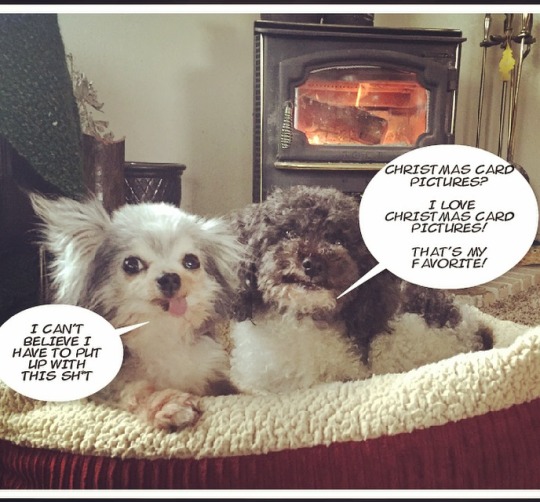
And sure, that level of enthusiasm for life is the hallmark of dogs as a species. One of the things I came to love about Kimba, though, was that he also had a quieter, more serious side.

He seemed downright introspective at times, and he often needed his space in a way that felt more cat-like than canine. He would snuggle up at bed time, but then disappear during the night, choosing to sleep solo on the sofa or in his dog bed by the fire.
Kimba also seemed to instinctively understand how to behave in various environments. He came with me on writing retreats, and was appropriately mellow.
(Well, with the exception of one chicken-chasing incident - which, I maintain, was entirely the fault of the chicken.)
When I was going through my divorce, I brought Kimba to some of my therapy sessions. The first time he came with me, Kimba stood on his hind legs to greet my therapist with a paw-shake. He gave the room a once-over, then hopped up onto the sofa and sat at attention, head tipped, waiting for the session to begin.
The therapist laughed, then said to me, “You do realize that’s not a dog you’ve got there, right? That is an old, old soul in a doggie suit.”
Indeed.
Daily, Kimba would hop onto my lap and I would smooth his ears back and tell him: You are sweetness and light in a poodle suit. Then he would hop back down and go about his business—most of which involved sharing that sweetness and light with the world.
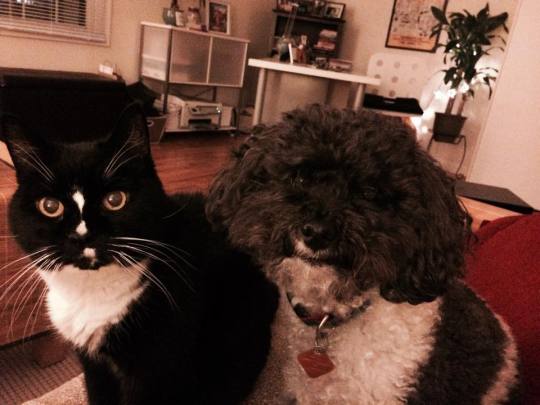
My tendency to rescue animals with disabilities or provide hospice care for those at the end of their lives was something Kimba not only tolerated, but welcomed. He was a natural at being a calming influence. It was almost as if serving other animals was as soothing to Kimba as helping him with his anxiety had alleviated my own.
Only one dog was impervious to Kimba’s charm.
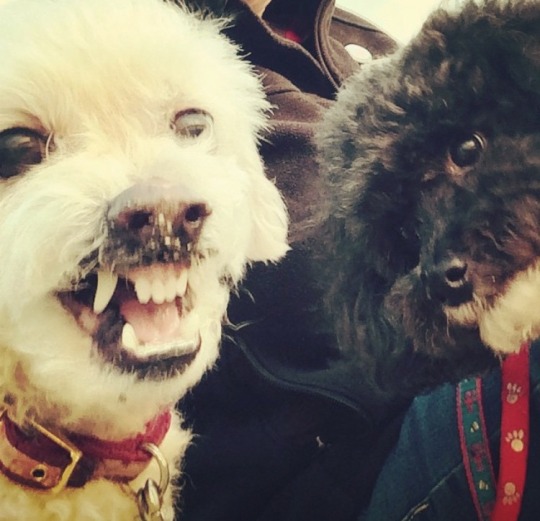
(A few chomps later, we decided Chopper was not best-placed with us.)
When Tiny Tim, the paralyzed Rottweiler, came home with us for his final hours, Kimba lay with me and Tim on the floor all night. He curled up on a pillow by Tiny Tim’s head—which was nearly as big as Kimba’s whole body—and every so often, he would touch his nose to Tim’s. I would hear Tim’s gentle exhale and know Kimba was working his Peace Poodle magic.
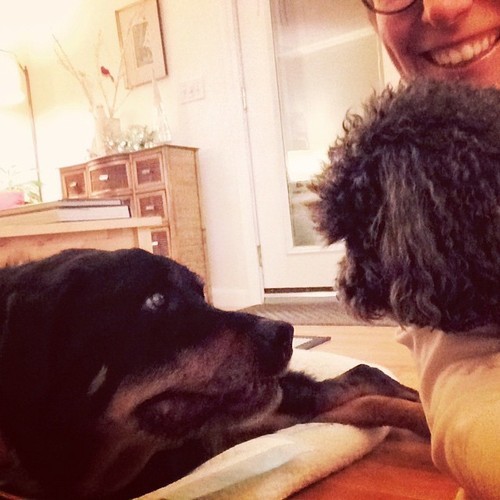
He brought so much joy to everyone he met, doing his silly poodle-dance or running in wild circles on the dog beach or tipping his nose at the sunroof and enjoying the wind in his ears on one of our many road trips.
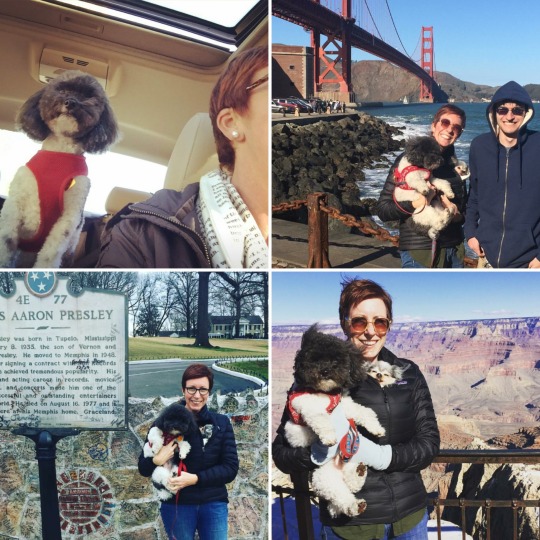
He enthusiastically hiked trails everywhere from New England to California. He reveled in getting filthy, then stoically tolerated being washed in the sink or fully re-poodled at the groomer’s.
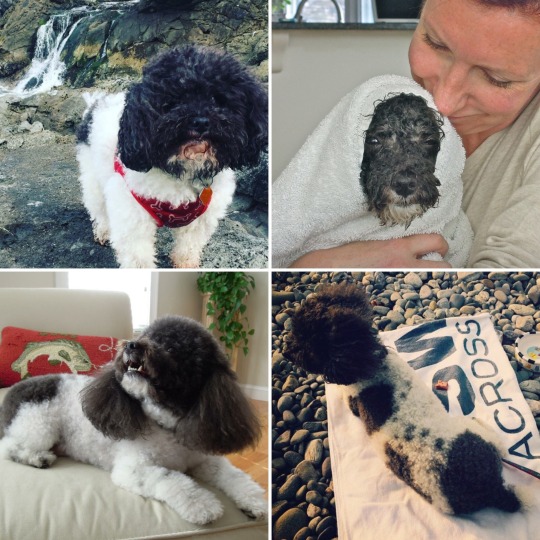
Kimba’s sudden passing the morning after Christmas is a thing that will haunt me forever. An open door, a moving car, and a moment’s inattention resulted in a terrible accident with an un-fixable outcome. It is small comfort to me that Kimba was in my arms as he passed.
My brave, independent poodle.
There’s nothing I wouldn’t give to have Kimba back with me. Those who have loved animals understand. They each hold a special place in your heart, yet with some there is just a deeper connection than with others.
Kimba was my little soul-poodle. There is an ache in his absence, and that weird wishful thinking that follows a death: clearly a mistake has been made, and if I can just appeal to the right god, all will be set right again.
As many friends have reminded me lately, the pain I feel right now is not for Kimba. Wherever Kimba is right now, in whatever form, he is not in pain. The sorrow I am experiencing is because his presence in my life was so great, his absence has left a tremendous void.
I used to joke that my primary relationship was with a 12-lb. poodle who loved to spoon.
No joke, really.
Now, as I write this, I have the tiniest dog imaginable at my side.
Mighty Little Max came to me and Kimba just a little over a year ago. His human had passed away and he was failing to thrive. Given his age and overall condition, the animal rescue was going to euthanize him. Kimba and I welcomed Max with the expectation that he might not have long to live.

Ha!
Max rallied big time, becoming Kimba’s enthusiastic little sidekick. I began referring to him as The Doglet Who Lived.
That Max is still here and Kimba is gone seems strangely ironic to me. But that’s how life goes, isn’t it? None of us knows how long we have. The biggest changes in our lives often come down to the smallest moments.
And yet.
Yet...
Mighty Little Max has kept close to my side since Kimba’s passing, and I’ve noticed something.
This 2.7 lb. scrap of a dog has picked up some of Kimba’s mannerisms. Kimba showed him the ropes, and I am certain Max is thriving today because of it. He comes to me each morning after breakfast. I ask him how his meal was, and he high-fives me, putting his tiny paw to my forefinger.
But now, I add: You are a brave, independent chihuahua. You are descended from wolves. Never forget that.
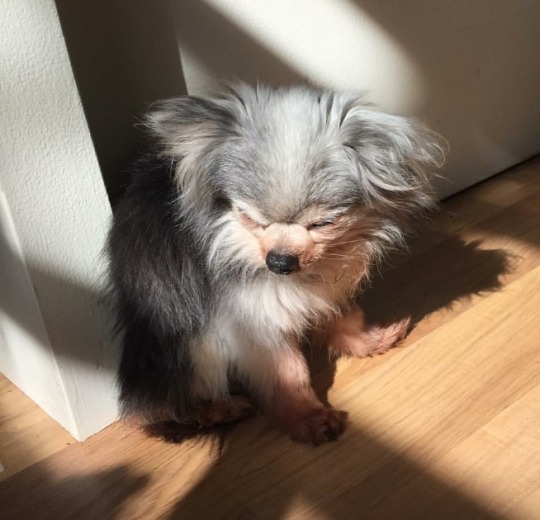
Mighty Little Max takes in the words with solemn understanding.
And somewhere deep within me, I know Kimba’s sweetness and light go on.

youtube
www.girlonawirekcw.com
#kimba#poodle#poodlicious#missingkimba#partipoodle#rescuedog#dogismycopilot#love#death#life#girlonawire#girlonawirekcw#kcwilder
0 notes